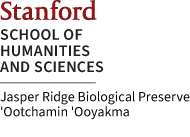Biodiversity
Introduction
- Chiariello N (2008)
Read the full introduction (PDF)
The butterfly assemblage of Jasper Ridge Biological Preserve
– Jérôme Pellet, Ph.D. (2008)
This report presents the results of a detailed butterfly survey conducted by Jérôme Pellet in six habitats within JRBP and in two adjoining habitats, a residential neighborhood and a former nursery. Using a widely accepted protocol called a modified Pollard walk, Jérôme identified 1242 individuals belonging to 37 butterfly species (36 within Jasper Ridge proper) over a 22-week period from March to September, 2006. The 37 species represent about half of all butterfly species recorded for San Mateo and Santa Clara counties. The high butterfly diversity of JRBP is best explained by habitat diversity because most species have narrow habitat distributions. Within the preserve, seven butterfly species were found only in the riparian community, while others were found uniquely in grassland, woodland, or scrubland. Another 11 species spanned just two habitats. Jérôme's report includes links to the data from his survey and to a pictorial guide to local butterflies.
Read full chapter (PDF)
Status of large and medium-sized mammals at JRBP
– Rodolfo Dirzo, Eduardo Mendoza E, Yolanda Cachú, and William Gomez (2009)
This report combines a summary of previous studies of medium-sized and large mammals at JRBP together with preliminary results from recent research, principally a camera-trapping study established by the report's authors. They conclude that historical information on mammals consists of a few natural history observations and presence/absence reports that together indicated the occurrence of 13 mammal species with body weight greater than 0.5 kg. The paucity of historical information highlights the importance of the camera-trapping study, which constitutes the first extensive, systematic, and quantitative study of medium-sized and large mammals at JRBP. In its first nine months (March-December 2006), the study acquired over 4,000 photos of animals at 12 camera stations situated on a hexagonal grid across the preserve. These photographic data provide the basis for much of the report. Five summary figures address variation in species abundance across camera stations, and seasonal and day vs. night activity. In addition, the report includes a list of recorded mammals and a map of the camera stations.
Read full chapter (PDF)
Primary production at Jasper Ridge Biological Preserve
– Claire Lunch (2009)
Since the late 1960s, nearly 50 peer-reviewed publications and dissertations have examined aspects of primary production at Jasper Ridge ranging in focus from leaf-level photosynthesis to airborne remote sensing of vegetation. Claire's report provides an overview of this large and very diverse literature, which includes some of JRBP's most influential publications. A recurring theme in the report is the relationship between productivity and four ecosystem parameters: moisture regime, geologic substrate, nitrogen availability, and plant community. For example, despite the mediterranean-type climate, annual rainfall is not a good predictor of annual biomass production in grasslands; spring- and summer-active species are more common than drought-deciduous species in the woody vegetation; and the dominant oak species exploit water resources over a larger area than their canopies. Claire also addresses scaling issues, especially in the context of tracing the effects of elevated CO2 from the level of photosynthesis, to plant growth, and to ecosystem carbon balance.
Read full chapter (PDF)



